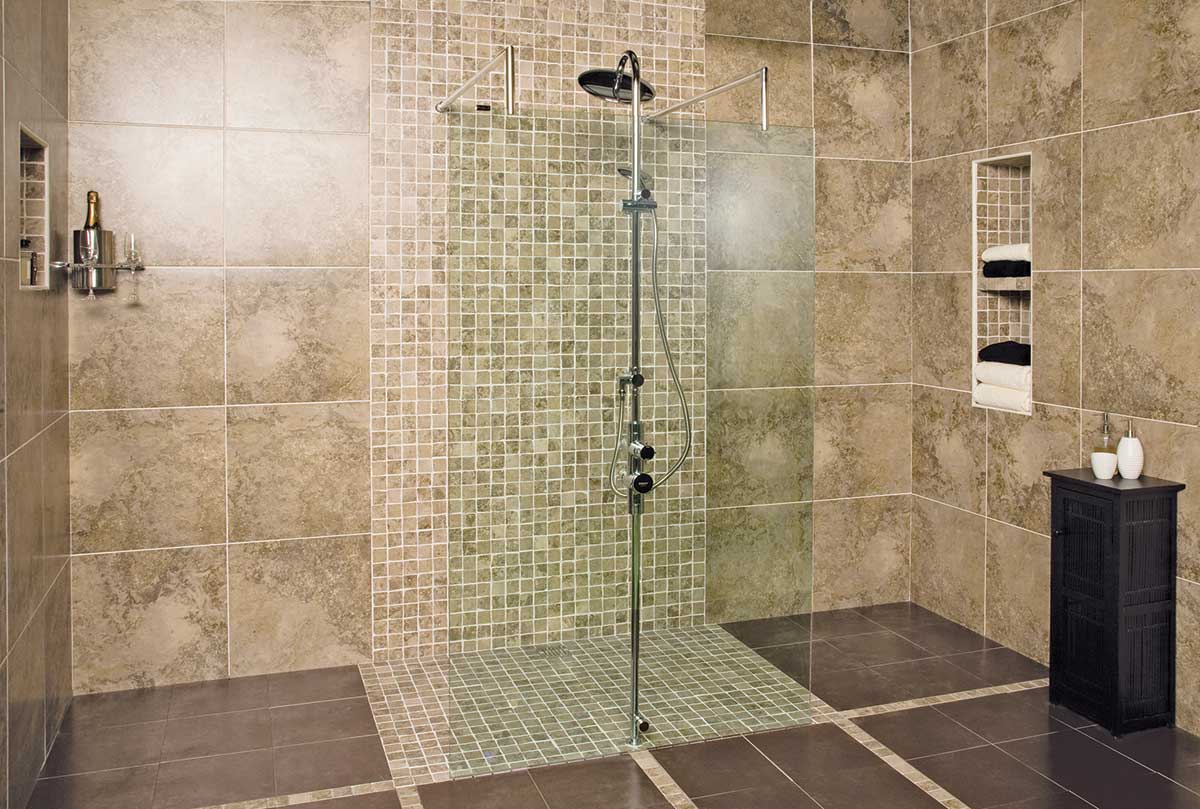Wet rooms and walk-in showers are especially useful for the elderly and those with reduced mobility but they can add style and value to your home too.
A ‘wet room’ is any part of a bathroom whose walls and floor have been properly waterproofed or ‘tanked’ like a swimming pool. It is dedicated to showering but has no visible shower tray. It has clean lines and lends itself to either contemporary or classic bathrooms. It’s become increasingly popular in recent years and many people now think them almost an essential for at least one of the bathrooms in a new build.
In practical terms they’re pleasant to use, as the flooring of the bathroom extends into the wet room area as one single zone without a step or separate visible shower tray. Regulations Planning permission wouldn’t generally be required but as with any alteration, if you’re installing one in a listed building you might.
If you’re planning a wet room in an existing, non-listed house you will need to adhere to certain building regulations, especially if you intend to move a wc. You’ll also have to be certain that your new pipework is tapped correctly into the existing soil pipe. Building control in NI will be inspecting this part of your project in a new build; in ROI self-builders often ask their design professional or engineer to inspect it. Ventilation is another requirement of the regulations, it will also ensure the floor area isn’t permanently wet. Water evaporated by your showering, and underfloor heating will need to escape somewhere. A good extractor will do the job or you may have a centralised system for your whole house that will deal with this.
Practical considerations If you intend to have a wet room you’ll need to discuss it with your designers very early on as they’ll have to think about how this will fit in with joist layout, drains, vents and soil pipes. A wet room cannot be an afterthought bolted on at the end of your build. A critical part of this planning is to ensure the correct positioning of the wet room waste pipe so it has a free flow of air. This usually involves running an independent wet room waste outlet.
Layout Will the wet room be the only bathroom in the house? If so, where will you put the wc, bath and basin? Unless you have a lot of space you’ll need to have a full-height glass ‘wall’ to keep splashes off other items in the room. Be careful, too, about having people walk across a wet floor to get to the wc. Plan your layout around where the door is. If the wet room is for the sole use of an adjacent bedroom, you’ll be able to think more creatively.
Universal design Plan for, or actually install, grab rails now; place the shower controls at a level that could be used easily by someone in a wheelchair, and take advice on loadings for support bars,so they’re good and strong right from the start. Most important of all, though, is planning to have plenty of space so a wheelchair can be safely manoeuvred, and a carer can do their work comfortably and safely.
Wet rooms are almost universal in the care-home and healthcare sectors where they are often the only way to make bathing possible. The critical thing when creating a wet room for wheelchair users is to be certain that the deck is constructed of very sturdy materials that can be guaranteed to take the weight. There can be formidable point loads where the wheels meet the floor and the underlying structures must be strong enough to cope.
Size A wet room can be almost any size, but to keep costs down select one that matches a standard tanking system tray. Most wet rooms therefore are about 120mm x 900mm (the size of a bath) but many people go for something about 2m x 2m. Anything more than this becomes a real luxury and will often be part of a much larger bathroom, perhaps with his and hers basins and bathroom furniture.
[powerkit_collapsibles]
[powerkit_collapsible title=”TANKING-SYSTEMS” opened=”true”]
The waterproof barrier
A popular myth about wet rooms is that they aren’t as safe as a shower tray and that they are prone to leaking. Not true. In fact, a properly installed wet room system is less likely to leak than a conventional shower tray and tile configuration. This is especially true in a retrofit where you may be dealing with wooden beams on a first or second floor. Over time, all buildings have some settling and especially with wooden flooring there is inevitably some movement between walls and floors.
A conventional shower tray with tiles sitting on top can then have a ‘gap’ appear between the two hard surfaces, and when the mastic eventually splits, you may have a leak. A tanking system involves the installation of a preformed tray with the correct gradient (1:40). Depending on the system there is then a waterproof membrane fitted glued over the tray and up the walls as well as out into the general bathroom.
This membrane is flexible by nature. Then the junctions of the membrane are sealed with a flexible tape and tar-like adhesive – all of which can tolerate some movement without leaking. It’s only then that the tiles are added on top. Any good tiler will try to ensure that the tiles themselves do their job and create a waterproof barrier, but if the junction then cracks, the tanking system provides a further line of defence.
The important thing is to make sure that your installer is using a recognised tanking system. What has given wet rooms a bad name is installers creating their own system using Waterproof Ply Board (WPB) as the base tray. While I have seen successful implementations done like this, they require a very skilled tradesperson. Ask your contractor what tanking system they are proposing to use and insist that it be from a reputable brand.
If you are going to do it yourself, it’s crucial to take your time, read the instructions and do exactly as instructed. When choosing a tanking system you need to be clear on the type of drain you are installing – is it a channel drain on one side, or a central drain which will require an envelope? This will determine the shape of the preformed tray you select. Like everything else in the bathroom, it is all about planning ahead.
Deirdre Coleman of ISdesign.ie
[/powerkit_collapsible]
[/powerkit_collapsibles]
Construction Although many years ago people said it was vital to have a concrete base (which is why so many wet rooms were installed downstairs), this is no longer the case. A wet room can be built on any type of floor including a concrete one. The most important features are the strong, waterproof tray onto which a special base is laid and a central, or offset, fast-draining outlet set into it.
The surface is then further waterproofed and tiled so it looks like a continuation of the rest of the flooring in the bathroom. Waterproofing of the walls and an area of about half a meter outside the immediate shower area is topped off with tiles, to create a pleasing, watertight, easily-cleaned shower area.
Drains Whilst most wet rooms have a central, or offset, drain there are now linear drains that run parallel to one side of the wet room – these are called ‘channel drains’. They look modern and sleek and work especially well if you’re using large format tiles. Linear drains are also helpful where there are joist position problems as water can be drained from any one of the three locations along the length of the drain.
DIY kits Various companies sell DIY wet room kits and the process isn’t technically difficult. This said, I recommend getting in the specialists because even the smallest mistakes or poor workmanship can wreak havoc in the future. The installation of wet rooms is all about meticulous attention to detail at every stage. A competent builder may well produce a good enough result, but a specialist will be up to date with the latest technology and will help you be creative on design as well.
Glass screens Unless you have a low powered shower and are extremely careful with how you use it, you’ll need to think about containing the splashes somehow, especially if you have a door or window, furniture, or even towel rails close by. Glass screens that are taller than normal shower cubicles will do the job. They can go right up to the ceiling if you like and can either be etched to provide modesty panels or be of completely clear or satin glass. It’s easy and not that expensive to have patterns or designs on this glass. The main issue with having more glass than you really need is that it’s a nuisance to keep clean; talk to your glazing company about protective coatings. Glass screens can be arranged to create an entire enclosure with one entry point, or to have double entry points.
Floor finishes Slip resistant tiles are rated by various means and the process isn’t standardised. Non-slip vinyl sheet surfaces tend to be the finish of choice for wheelchair users but bear in mind not all wet-room trays are suitable for vinyl flooring.
Underfloor heating This is a good idea for a wet room and makes it feel luxurious to use. When starting from scratch it’s easy to build in electric heating mats under the tiling; this system of underfloor heating heats up faster than a piped underfloor type. It’s not necessary to have underfloor heating under the shower area itself as the slope on the floor towards the drain will mean water doesn’t lie there.
Electrics Wet rooms are considered to be Zone 0, which means that, effectively, all fittings have to be totally immersionproof. No mains voltage can be fitted to the room, including shaver sockets, light switches or standard sockets. Lights should be enclosed and mounted on or in the ceiling, with a remote pull-cord to switch them. Electric and gas heaters should be installed at a safe distance from the shower area, with controls outside the shower area. Get your electrician to advise you about suitable IP-rated (ingress protection) fittings.
Cost will obviously depend on size, whether you’re having to strip out an old bathroom, how demanding your design is and what you are prepared to spend on tiles and fittings. If starting from scratch, the cost of installing a wet room style shower is about 20 per cent more than a conventional, high quality shower tray. There are lots of stages and elements involved in the construction of a wet room including: a shower tray former; tanking materials; various drainage parts; underfloor heating; the shower itself; screening; tiles and labour (two people will take about five days to create the average wet room).
This all adds up to about £5,000/€5,500 for a 2m x 2m wet room. This figure includes tiling, a cost that also applies to conventional shower tray installations. If you intend to build a whole new room from scratch, then costs will be higher.
Grants In ROI check the Housing Adaptation Grants, up to €30,000 available to make the house wheelchair friendly, alongside Mobility Aid Grants with a €6,000 cap, and Housing Aid for Older Persons Scheme with €8,000 cap. In NI there’s the Disabled Facilities Grant which can fund up to £25,000 on a whole house upgrade depending on financial circumstances.









